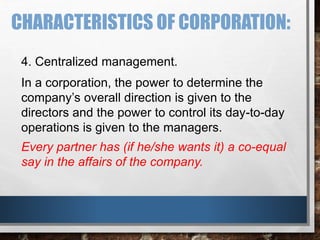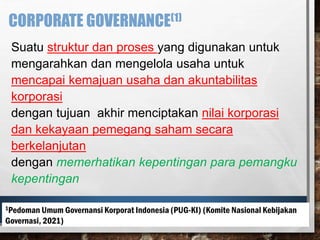Chapter 1 CG.pdf
- 2. • Corpus (body), a body of people organized to act as one • draw resources from a variety of groups and establish and maintain its own persona separate from all of them • a structure established by law to allow different parties to contribute capital, expertise, and labor for the maximum benefit of all of them. CORPORATION
- 3. • Legal Ficition • do not actually exist but have legal significance anyway • not human beings, but have some of the rights and powers that people have • The assets of a corporation are owned by shareholders and managed by the corporation’s executive and board. CORPORATION
- 4. CHARACTERISTICS OF CORPORATION (Monks & Minow, 2011) 1. Limited Liability The corporation is separate from its owners and employees. If a corporation goes bankrupt and is sued by its creditors for recovery of debts, the individual members of the corporation are not individually liable
- 5. CHARACTERISTICS OF CORPORATION: 2. Transferability The ability to transfer one’s holding freely A partnership interest is complicated and difficult to value, and there is no stock exchange where partnership interests can be traded. By contrast, stock is almost as liquid as cash.
- 6. CHARACTERISTICS OF CORPORATION: 3. Legal Personality A corporation lives on for as long as it has capital. A partnership dies with its partners, or it dies when one partner decides to quit. Continuing after the death or resignation of the partners can be complicated and expensive
- 7. CHARACTERISTICS OF CORPORATION: 4. Centralized management. In a corporation, the power to determine the company’s overall direction is given to the directors and the power to control its day-to-day operations is given to the managers. Every partner has (if he/she wants it) a co-equal say in the affairs of the company.
- 8. There are two views as to whom the corporation has a responsibility: (1) the shareholders only, or (2) the shareholders as well as the community, employees, and the economy. However… To meet the needs of the shareholder would mean that the corporation maximizes its share value, which would be done by building the most successful business possible thus meeting the needs of other parties. PURPOSE
- 9. Meeting the needs of Employees by providing job security and adequate support for employees Meeting the needs of Community by enacting a social consciousness Meeting the needs of Market Members by providing service & value to customers/ clients Meeting the needs of Shareholders by promoting stock value Interrelated Obligations of a Corporation
- 11. •Corporations have an obligation to meet the needs of the economy (in addition to shareholder’s) •Government intervention and regulation of corporate activity is geared toward protecting the interests of the economy and the society while at the same time fostering successful business efforts THE GOVERNMENT, THE ECONOMY & THE CORPORATION
- 12. THE GOVERNMENT, THE ECONOMY & THE CORPORATION • sustaining of a successful economy that provides jobs • establishment of regulations : fair treatment, safe working environ, & minimum pay The employee • fostering of a competitive marketplace provides variety • against consumer fraud, hazardous products, and other consumer-related risks The consumer • the establishment of laws and policies that regulate hazardous materials, pollution, and other environmentally unsound practices The environment • the establishment of policies that encourage market growth and investment, while preventing accounting fraud and other economically damaging activities The economy
- 13. •Related with how corporations raise fund/finance themselves •May include combination of Equity, Bonds, and loans •The exact formula used is different for each corporation •every entity works to discover the optimal combination that provides the greatest stock value and lowest cost. CAPITAL STRUCTURE
- 14. GOVERNANCE
- 15. Suatu struktur dan proses yang digunakan untuk mengarahkan dan mengelola usaha untuk mencapai kemajuan usaha dan akuntabilitas korporasi dengan tujuan akhir menciptakan nilai korporasi dan kekayaan pemegang saham secara berkelanjutan dengan memerhatikan kepentingan para pemangku kepentingan CORPORATE GOVERNANCE(1) 1Pedoman Umum Governansi Korporat Indonesia (PUG-KI) (Komite Nasional Kebijakan Governasi, 2021)
- 16. •Corporate governance involves a set of relationships between a company’s management, its board, its shareholders and other stakeholders. •Corporate governance also provides the structure through which the objectives of the company are set, and the means of attaining those objectives and monitoring performance are determined. CORPORATE GOVERNANCE ECD (2015), G20/OECD Principles of Corporate Governance, OECD Publishing, Paris. http://dx.doi.org/10.1787/9789264236882-en
- 17. Meeting the needs of Employees by providing job security and adequate support for employees Meeting the needs of Community by enacting a social consciousness Meeting the needs of Market Members by providing service & value to customers/ clients Meeting the needs of Shareholders by promoting stock value Interrelated Obligations of a Corporation CORPORATE GOVERNANCE oHak dan kewajiban serta hubungan di antara stakeholders oBukan saja untuk kepentingan shareholders tetapi menjaga keseimbangan dengan kebutuhan stakeholders yang lainnya
- 18. CORPORATE GOVERNANCE Governansi > tata Kelola Frasa tata kelola dalam korporasi lebih berfokus pada pengurusan internal korporasi, sedangkan Governansi berkaitan dengan pemangku kepentingan yang lebih luas
- 19. Corporate governance system is the combination of mechanisms which ensure that the management runs the firm for the benefit of one or several stakeholders. •Stakeholders may cover shareholders, creditors, suppliers, clients,employees and other parties with whom the firm conducts its business CORPORATE GOVERNANCE
- 20. CORPORATE GOVERNANCE THEORY AGENCY THEORY (Jensen and Meckling 1976) the conflicts of interests that may exist between a so-called agent (Management) and the agent’s principal (shareholders) - MORAL HAZARD While the agent has been asked by the principal to carry out a specific duty, the agent may not act in the best interest of the principal once the contract between the two parties has been signed and may prefer to pursue his own interests. - ASYMMETRIC INFORMATION refers to situations where one party, typically the one that agrees to carry out a certain duty or agrees to behave in a certain way, i.e. the agent, has more information than the other party, the principal
- 22. Struktur Governansi Korporat (UU No.40 tahun 2007) CORPORATE GOVERNANCE • RUPS • Kumpulan para pemegang saham korporasi Organ kepemilikan • Direksi • Mengelola korporasi Organ pengelolaan • Komisaris • Mengawasi aktivitas pengelolaan direksi Organ pengawasan forum pertanggungjawaban Direksi dan Komisaris
- 24. (Maria Aluchna in Handbook of Corporate Governance and Social Responsibility, Edited by Güler Aras and David Crowther, 2010)
- 25. CORPORATE GOVERNANCE Prinsip Governansi Indonesia (8 Prinsip) Kelompok prinsip yang mengatur fungsi pengurusan (Direksi) dan pengawasan (Komisaris) korporasi PRINSIP 1 - 3 Kelompok prinsip yang mengatur proses dan keluaran yang dihasilkan oleh Direksi dan Dewan Komisaris PRINSIP 4 - 6 Kelompok prinsip yang mengatur pemilik sumberdaya, yang terutama akan menerima manfaat dari pelaksanaan governansi korporat PRINSIP 7 -8
- 26. CORPORATE GOVERNANCE Prinsip 1: Peran dan Tanggung Jawab Direksi dan Dewan Komisaris Prinsip 2: Komposisi dan Remunerasi Direksi dan Dewan Komisaris Prinsip 3: Hubungan Kerja antara Direksi dan Dewan Komisaris Prinsip 4: Perilaku Etis Prinsip 5: Manajemen Risiko, Pengendalian Intern dan Kepatuhan Prinsip 6: Pengungkapan dan Transparansi Prinsip 7: Hak-hak Pemegang Saham Prinsip 8: Hak-hak Pemangku Kepentingan
- 27. CORPORATE GOVERNANCE Pilar Governansi Korporat Transparansi Akuntabilitas Responsibilitas Independensi Keadilan/ Kesetaraan (Fairness) Perilaku Beretika Akuntabilitas Transparamsi Keberlanjutan Pedoman Umum Governansi Korporat Indonesia tahun 2019 Pedoman Umum Governansi Korporat Indonesia tahun 2021





























